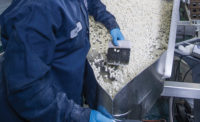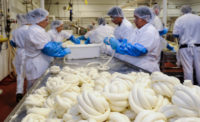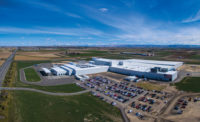To see how White Clover Dairy grew up to become Arla Foods, it helps to look at a series of aerial photos hung in the entrance hallway to this cheese plant in Hollandtown, Wis. In the first image there is a farmhouse near the original plant. Later images show how expansions to the plant crept closer and closer to the house. Eventually, the plant completely surrounds the farmhouse, and in the last image, the house is gone. These additions over the years turned the facility into a 110,000-square-foot plant.
White Clover had been making Havarti for Arla. Then in 2006, Arla bought the plant, which is located 25 miles south of Green Bay. By 2011, the new owners had doubled the capacity of the plant and kept investing in it. The 225 plant employees can produce 32 million pounds of cheese annually.
The cheesemaker’s investments in the plant were aligned with its long-term goal: increase Arla’s presence in the supermarket cheese aisle in order to compete with established national and regional brands. Although Arla does sell cheese in the deli department, growth will come from the high-volume cheese aisle, said CEO Don Stohrer Jr. (See related article.)
This plant is the largest producer of Havarti cheese in the United States. Havarti accounts for about 70% of the plant’s output, with Gouda accounting for 20% and other cheese types (Edam, Fontina and Muenster) making up the remainder. Almost all the product is branded Arla. The plant does a small private label business.
The total Havarti cheese category was worth $76.6 million in 2014, when grocers sold 8.8 million pounds, according to IRI, the Chicago-based research firm. The most popular cheese that year was Cheddar; volume sales of 766.5 million pounds were worth $3.9 billion.
Gouda is growing in popularity. U.S. cheesemakers produced 58.3 million pounds in 2015 compared to 16.2 million pounds in 2011, according to the National Agricultural Statistics Service of the U.S. Department of Agriculture. (Statistics for Havarti are not available.)
That the plant in Hollandtown makes a Danish cheese is no surprise. The U.S. operation is a subsidiary of Arla, a dairy cooperative based in Denmark. The co-op is owned by 14,000 farmers from Denmark, Sweden, the UK, Germany, Belgium, Luxemburg and the Netherlands.
Milk receiving and testing
Jason Mathis, who began his career in the laboratory and today is the production, technology and development manager, led Dairy Foods on a tour of the plant. Milk arrives daily between 9 a.m. and 5 p.m. Arla sends its own trucks to 45 independent dairies within a 65-mile radius to collect milk. The plant receives about 840,000 pounds of rBST-free milk daily. It is all traceable to a specific farm.
The on-site lab runs chemical and microbiological tests on each load of milk. The Food and Drug Administration’s Interstate Milk Shippers list has approved the lab to conduct certain tests. The lab tests raw milk samples for somatic cell counts, plate counts and other measures of cleanliness. When the results come back negative, the milk is pumped into two silos. The tankers are cleaned and sent back on the road. Farmers are paid bonuses based on the quality of the milk and for components, such as high levels of fat and protein.
The raw milk is pasteurized in a high-temperature, short-time plate heat exchanger and run through a separator. The milk is standardized according to the cheese recipe that will be produced that day. Arla has 22 basic recipes. The amount of cream that is required is based upon the cheese type. Gouda is a lower-fat cheese compared to Havarti, and thus calls for less cream. The Wisconsin plant follows the same Havarti recipe used by its European counterparts. If there is a difference in the taste of the cheese, it is because of the milk, Mathis said.
Cheese production
After pasteurization, milk is pumped into double-O vats. Arla has three 20,000-pound-capacaity vats and three 35,000-pound-capacity ones in its vat room. On the day of our visit, three vats were reserved for Gouda and three for Havarti. Cultures and rennet are added to the milk and the mixture is cooked. When the curds are created, they are pumped from the vats to casomatic cheese towers. Arla has a Gouda system and a Havarti system. When it installed separate casomatic towers in 2011, the plant essentially doubled its capacity, Mathis said. Prior to 2011 it could only make one cheese type at a time.
As whey drains from the curd, it is collected and then treated by a reverse-osmosis process. Some whey is sold as an ingredient. Other whey is retained and “polished” to be used for CIP purposes inside the plant.
What’s notable about Arla’s operation is the level of automation. Master cheesemaker Duane Petersen keeps an eye on every phase, but only a handful of associates are needed on the floor during a production shift. They keep an eye on steps such as the dispensing of curds into the hoops and make sure there are no jams. Automation allows the cheesemaker to have more precision and control over the final product. It is also safer, Mathis said.
Arla was making 7-ounce Gouda wheels during our visit. Curds fell through the tower into molded plastic forms consisting of 15 hoops. Pressure was applied to the forms to remove additional whey. The plant also makes Gouda in 24-pound blocks, 5-pound wheels and 10-pound wheels. After brining, these cheeses go through a two-step wax bath that creates the traditional red rind of a Gouda.
In the Havarti production room, Arla was making 34-pound blocks. After the curd knits, the blocks of cheeses are removed from the hoops then move by water and conveyor belt to the brining room.
In addition to plain and light varieties, some cheeses end up flavored or naturally smoked. Havarti flavors include dill, jalapeno and caraway. Gouda flavors include chili lime, chipotle, pesto and reserve. In the in-plant smokehouse, Havarti and Gouda are cold-smoked with hickory smoke at ambient temperature. Gouda flavors include flamed smoked and smoked with cracked peppercorns.
After manufacturing, all the cheeses are sent across the street to a warehouse where they age for about 28 days. Then they are trucked back to the plant to be cut and wrapped.
Cut and wrap room
In 2014, Arla remodeled its conversion area and installed a new slicing line which increased the plant’s throughput, Mathis said. All of the sliced cheese is packed in flow-wrap packaging. The product assortment for slices is 8 ounces, 10 ounces, 24 ounces and 32 ounces.
While the cheesemaking process is highly automated, cutting and wrapping is a different story. In this part of the plant, teams of employees at each station are busy removing plastic wrappers from the cheeses and feeding wheels and blocks through windows into the cutting room. Arla was packaging Gouda wedges and Havarti bricks during our visit. A shingle line, which converts blocks to slices, was down for scheduled maintenance.
To make wedges (called “cake cuts”), an associate places a 5-pound Gouda wheel on a stand and forces a wire harp into it. Wedges fall away as 10-ounce portions. Associates then put these cuts into plastic bags which are then conveyed to a vacuum sealer.
On another line, nine-pound loaves of Havarti are cut into 8-ounce bricks that drop into pockets lined with plastic film. These portions will be sealed and gas-flushed. All of the packaged cheese is labeled and passes through metal detection equipment. The packages exit the cutting room via conveyor into a packing room where associates pack them into cartons, which are then sent to a distribution center.
The federal Food and Drug Administration inspects the plant, as does the Wisconsin Department of Agriculture. The U.S. Department of Agriculture inspects the plant twice a year. Its unannounced inspections cover more than 100 items, including milk supply, plant facilities, condition of equipment, sanitary practices, and processing procedures. The Hollandtown plant has received approval for USDA’s grading service.
The facility achieved SQF Level 3 certification in 2012 (from Level 2, attained in 2009) and has maintained it ever since. Some customers also make their own audits.
“We take pride in our quality,” Mathis said. The SQF certification “sets the foundation of what’s important to us to make sure that we finish the cheese at the highest quality all the time.”
Before cheeses are released, samples are evaluated at a weekly meeting. Committee members look at the surface, color, structure, body, flavor and distribution of spices, Mathis said. Master Cheesemaker Petersen participates with individuals from the quality assurance and packaging departments. Besides tasting and looking at cosmetic features, the evaluators look for any issues related to packaging.
A measure of the quality are the honors the plant receives from its peers. At the 2016 World Championship Cheese Contest, the Hollandtown Havarti cheeses took first, second and third places. The Wisconsin plant beat out entries from other Arla cheesemakers.
Arla’s next cheesemaking project is a joint venture with the U.S. dairy cooperative Dairy Farmers of America. The co-op is building a Cheddar plant in western New York state. DFA, which owns 80% of the venture, will be manufacturing Cheddar from rBST-free milk. Arla will be responsible for selling and marketing it. The plant will be online in 2018. When that happens, Arla will be competing in the second largest cheese category in the United States. (Only mozzarella is larger.)
Arla’s Master Cheesemaker is in rare company
Arla’s Duane Petersen knows cheese better than most individuals. He has the certification to prove it, too. Petersen holds the coveted Wisconsin Master Cheesemaker certification in three cheeses: Edam and Gouda (earned in 2002) and Havarti (2015).
Petersen is one of 65 active Master Cheesemakers in the state. Of these, just 22 are certified in more than two cheeses, according to Marianne Smukowski with the Wisconsin Center for Dairy Research in Madison.
The certification is overseen by the Wisconsin Center for Dairy Research, UW-Extension, and the Wisconsin Milk Marketing Board. It takes 2 years and 8 months from the time cheesemakers are accepted into the program until they graduate. But before they can apply, applicants need 10 years of cheesemaking experience.
Petersen has been at it for more than 40 years. He began working in a cheese factory at age 14 to save money for college. He continued working at the plant while earning an associate’s degree.
Today, besides making cheese, Petersen helps to keep equipment up-to-date, monitors the cheese recipes, makes sure everything runs smoothly and mentors cheesemakers.










